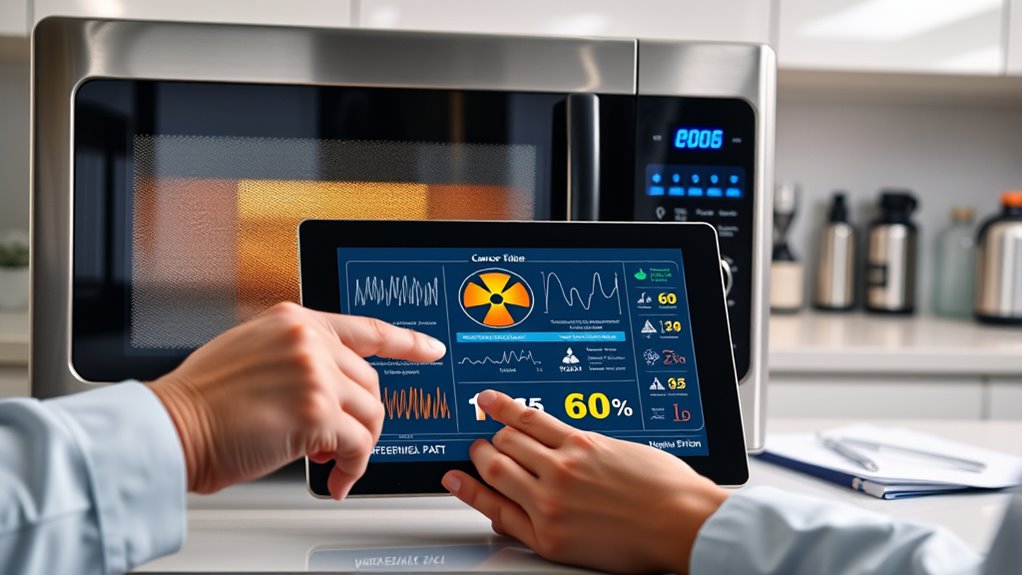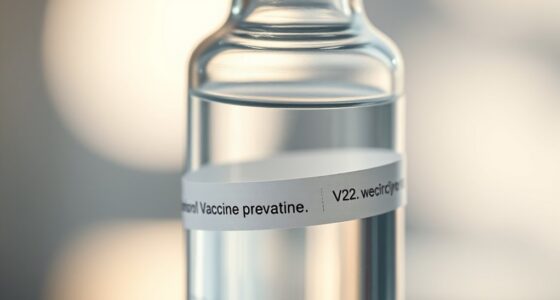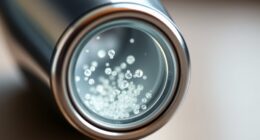Microwave ovens emit non-ionizing radiation, which doesn’t damage DNA or cause cancer. When used properly, they contain radiation safely within the appliance thanks to shielding and door seals. Proper handling, like avoiding metal containers and using microwave-safe covers, ensures safe food preparation. Scientific consensus confirms that with correct use, microwaves don’t increase cancer risk. If you’d like to understand more about how microwave radiation compares to other forms and safety tips, there’s much more to discover below.
Key Takeaways
- Microwave ovens emit non-ionizing radiation, which cannot directly damage DNA or cause cancer.
- Properly maintained microwaves are safe; built-in shielding and door seals prevent radiation leakage.
- Using microwave-safe containers and avoiding metal helps ensure safe heating without health risks.
- Scientific consensus affirms that proper microwave use does not increase cancer risk.
- Focus on healthy diet and lifestyle choices for cancer prevention, not on microwave radiation exposure.

Many people wonder if using a microwave oven can increase their risk of cancer. This concern often stems from fears about radiation exposure and the potential health effects of microwave radiation. The truth is, microwave ovens are designed with safety in mind, and when used correctly, they don’t pose a significant risk to your health.
Understanding microwave safety is essential for cancer prevention, as it helps you make informed choices about food preparation and handling. The main concern revolves around whether microwave radiation can cause genetic damage or lead to cancer, but these fears are largely unfounded.
Microwave ovens emit non-ionizing radiation, which is different from the ionizing radiation found in X-rays or nuclear materials. Non-ionizing radiation doesn’t have enough energy to break chemical bonds or damage DNA directly.
Microwave radiation is non-ionizing and cannot directly damage DNA or cause cancer.
When you use a microwave properly, the radiation is contained within the oven, and the appliance is built with multiple safety features, such as shielding and interlock mechanisms, to prevent leakage. As long as your microwave is in good condition and the door seals well, it’s safe to operate.
Regular maintenance and avoiding damaged units are key components of microwave safety that support cancer prevention.
Using a microwave correctly also involves following proper food handling practices. For instance, avoid heating food in containers with metal parts or those that aren’t microwave-safe, as these can cause sparks or uneven heating.
Uneven heating might leave some parts of your food undercooked, potentially allowing bacteria to survive, but it’s not linked to cancer risk. Instead, ensure you stir or rotate food during heating to promote even cooking.
Covering your food with microwave-safe lids or wraps helps prevent splatters and retains moisture, ensuring thorough heating. These practices are part of safe microwave use, which reduces the risk of foodborne illnesses rather than cancer.
When it comes to cancer prevention, the focus should be on maintaining a balanced diet, avoiding processed foods, and reducing exposure to known carcinogens, rather than worrying excessively about microwave radiation.
Using your microwave as intended, with attention to microwave safety, is a convenient way to prepare healthy meals without introducing unnecessary risks.
The scientific consensus confirms that microwave ovens, when used properly, don’t increase your cancer risk. They’re a safe and efficient tool for cooking and reheating food, provided you follow manufacturer instructions and avoid damaged appliances.
Frequently Asked Questions
Can Microwave Exposure Cause Genetic Mutations?
You might wonder if microwave exposure can cause genetic mutations. While microwaves produce non-ionizing radiation, they don’t have enough energy to directly damage your DNA or cause genetic mutations.
According to current research, typical microwave exposure doesn’t lead to DNA damage or mutations. You’re safe from genetic risks related to microwave radiation, as it doesn’t share the harmful properties of ionizing radiation like X-rays or gamma rays.
Are Microwave Ovens Safe for Children?
You’re wondering if microwave ovens are safe for children. Generally, proper oven design guarantees they emit minimal microwave radiation when used correctly, making them safe for child safety.
It’s essential to supervise children around microwaves and teach them how to use them properly. As long as you follow safety guidelines, microwave ovens pose little risk to children, and they can enjoy their food without concerns about radiation exposure.
How Do Microwave Frequencies Compare to Other Radiation Types?
Imagine a gentle wave of light, moving through the air—your microwave’s electric field vibrates within a specific frequency range, much lower than X-rays or gamma rays.
Compared to other radiation types, microwave frequencies are non-ionizing, meaning they lack the energy to damage DNA.
Their electric field oscillates at a safer, less intense rate, making them fundamentally different from high-energy radiation, which can pose health risks.
Is There a Safe Duration to Use Microwave Ovens Daily?
You might wonder about microwave safety and daily usage guidelines. The good news is, using your microwave within recommended limits is safe. Most experts agree that occasional or moderate daily use doesn’t pose health risks.
To stay safe, follow manufacturer instructions and avoid prolonged exposure to microwave radiation. As long as you use your microwave properly, there’s no need to worry about harmful effects from daily use.
Do Microwave Leaks Pose Health Risks Over Time?
You might wonder if microwave leaks pose health risks over time. Regular leak detection guarantees your microwave stays safe, as even minor leaks can release electromagnetic radiation.
Following health guidelines, such as maintaining your appliance and checking for leaks annually, helps prevent potential exposure. By staying vigilant, you can enjoy the convenience of microwave cooking without worrying about long-term health effects from leaks.
Conclusion
While concerns about microwaves and cancer persist, current evidence shows no clear link. Imagine a mother worried about her child’s safety, only to learn that using her microwave is safe when used properly. Remember, understanding facts helps you make informed choices. Keep informed, stay cautious, but don’t let fear overshadow the science. Your safety depends on separating fiction from fact, so trust reliable sources and continue to prioritize your health.









